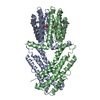+ Open data
Open data
- Basic information
Basic information
| Entry | Database: PDB / ID: 8zvf | ||||||
|---|---|---|---|---|---|---|---|
| Title | AtALMT9 plus high malate in low pH | ||||||
 Components Components | Aluminum-activated malate transporter 9 | ||||||
 Keywords Keywords | TRANSPORT PROTEIN / CHANNEL | ||||||
| Function / homology | malate transport / Aluminum-activated malate transporter / Aluminium activated malate transporter / plant-type vacuole membrane / monoatomic anion channel activity / 1,2-DILAUROYL-SN-GLYCERO-3-PHOSPHATE / Aluminum-activated malate transporter 9 Function and homology information Function and homology information | ||||||
| Biological species |  | ||||||
| Method | ELECTRON MICROSCOPY / single particle reconstruction / cryo EM / Resolution: 3.59 Å | ||||||
 Authors Authors | Gong, D.S. | ||||||
| Funding support | 1items
| ||||||
 Citation Citation |  Journal: Cell Rep / Year: 2024 Journal: Cell Rep / Year: 2024Title: Structural insight into the Arabidopsis vacuolar anion channel ALMT9 shows clade specificity. Authors: Dandan Qian / Yaru Chai / Weiping Li / Bin Cui / Shaoquan Lin / Zhibin Wang / Chongyuan Wang / Le Qing Qu / Deshun Gong /  Abstract: The Arabidopsis thaliana aluminum-activated malate transporter 9 (AtALMT9) functions as a vacuolar chloride channel that regulates the stomatal aperture. Here, we present the cryoelectron microscopy ...The Arabidopsis thaliana aluminum-activated malate transporter 9 (AtALMT9) functions as a vacuolar chloride channel that regulates the stomatal aperture. Here, we present the cryoelectron microscopy (cryo-EM) structures of AtALMT9 in three distinct states. AtALMT9 forms a dimer, and the pore is lined with four positively charged rings. The apo-AtALMT9 state shows a putative endogenous citrate obstructing the pore, where two W120 constriction residues enclose a gate with a pore radius of approximately 1.8 Å, representing an open state. Interestingly, channel closure is solely controlled by W120. Compared to wild-type plants, the W120A mutant exhibits more sensitivity to drought stress and is unable to restore the visual phenotype on leaves upon water recovery, reflecting persistent stomatal opening. Furthermore, notable variations are noted in channel gating and substrate recognition of Glycine max ALMT12, AtALMT9, and AtALMT1. In summary, our investigation enhances comprehension of the interplay between structure and function within the ALMT family. | ||||||
| History |
|
- Structure visualization
Structure visualization
| Structure viewer | Molecule:  Molmil Molmil Jmol/JSmol Jmol/JSmol |
|---|
- Downloads & links
Downloads & links
- Download
Download
| PDBx/mmCIF format |  8zvf.cif.gz 8zvf.cif.gz | 143.7 KB | Display |  PDBx/mmCIF format PDBx/mmCIF format |
|---|---|---|---|---|
| PDB format |  pdb8zvf.ent.gz pdb8zvf.ent.gz | 109.3 KB | Display |  PDB format PDB format |
| PDBx/mmJSON format |  8zvf.json.gz 8zvf.json.gz | Tree view |  PDBx/mmJSON format PDBx/mmJSON format | |
| Others |  Other downloads Other downloads |
-Validation report
| Summary document |  8zvf_validation.pdf.gz 8zvf_validation.pdf.gz | 1.2 MB | Display |  wwPDB validaton report wwPDB validaton report |
|---|---|---|---|---|
| Full document |  8zvf_full_validation.pdf.gz 8zvf_full_validation.pdf.gz | 1.3 MB | Display | |
| Data in XML |  8zvf_validation.xml.gz 8zvf_validation.xml.gz | 43.9 KB | Display | |
| Data in CIF |  8zvf_validation.cif.gz 8zvf_validation.cif.gz | 58.8 KB | Display | |
| Arichive directory |  https://data.pdbj.org/pub/pdb/validation_reports/zv/8zvf https://data.pdbj.org/pub/pdb/validation_reports/zv/8zvf ftp://data.pdbj.org/pub/pdb/validation_reports/zv/8zvf ftp://data.pdbj.org/pub/pdb/validation_reports/zv/8zvf | HTTPS FTP |
-Related structure data
| Related structure data |  60510MC  8hiwC  8hiyC M: map data used to model this data C: citing same article ( |
|---|---|
| Similar structure data | Similarity search - Function & homology  F&H Search F&H Search |
- Links
Links
- Assembly
Assembly
| Deposited unit | 
|
|---|---|
| 1 |
|
- Components
Components
| #1: Protein | Mass: 67121.008 Da / Num. of mol.: 2 Source method: isolated from a genetically manipulated source Source: (gene. exp.)   #2: Chemical | Has ligand of interest | Y | |
|---|
-Experimental details
-Experiment
| Experiment | Method: ELECTRON MICROSCOPY |
|---|---|
| EM experiment | Aggregation state: PARTICLE / 3D reconstruction method: single particle reconstruction |
- Sample preparation
Sample preparation
| Component | Name: Dimer of AtALMT9 / Type: COMPLEX / Entity ID: #1 / Source: RECOMBINANT |
|---|---|
| Source (natural) | Organism:  |
| Source (recombinant) | Organism:  |
| Buffer solution | pH: 5.5 |
| Specimen | Embedding applied: NO / Shadowing applied: NO / Staining applied: NO / Vitrification applied: YES |
| Vitrification | Cryogen name: ETHANE |
- Electron microscopy imaging
Electron microscopy imaging
| Experimental equipment |  Model: Titan Krios / Image courtesy: FEI Company |
|---|---|
| Microscopy | Model: FEI TITAN KRIOS |
| Electron gun | Electron source:  FIELD EMISSION GUN / Accelerating voltage: 300 kV / Illumination mode: FLOOD BEAM FIELD EMISSION GUN / Accelerating voltage: 300 kV / Illumination mode: FLOOD BEAM |
| Electron lens | Mode: BRIGHT FIELD / Nominal defocus max: 1800 nm / Nominal defocus min: 1300 nm |
| Image recording | Electron dose: 71 e/Å2 / Film or detector model: GATAN K3 (6k x 4k) |
- Processing
Processing
| EM software | Name: PHENIX / Version: 1.20.1_4487: / Category: model refinement |
|---|---|
| CTF correction | Type: PHASE FLIPPING AND AMPLITUDE CORRECTION |
| 3D reconstruction | Resolution: 3.59 Å / Resolution method: FSC 0.143 CUT-OFF / Num. of particles: 118165 / Symmetry type: POINT |
 Movie
Movie Controller
Controller





 PDBj
PDBj

